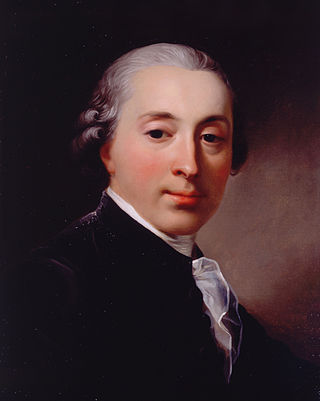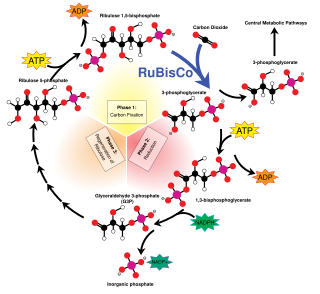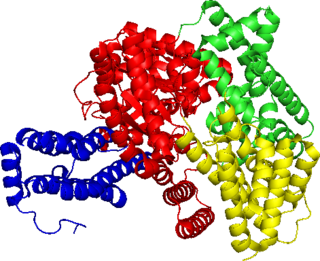Related Research Articles

Photosynthesis is a process used by plants and other organisms to convert light energy into chemical energy that, through cellular respiration, can later be released to fuel the organism's activities. Some of this chemical energy is stored in carbohydrate molecules, such as sugars and starches, which are synthesized from carbon dioxide and water – hence the name photosynthesis, from the Greek phōs, "light", and synthesis, "putting together". Most plants, algae, and cyanobacteria perform photosynthesis; such organisms are called photoautotrophs. Photosynthesis is largely responsible for producing and maintaining the oxygen content of the Earth's atmosphere, and supplies most of the energy necessary for life on Earth.
Isoprene, or 2-methyl-1,3-butadiene, is a common volatile organic compound with the formula CH2=C(CH3)−CH=CH2. In its pure form it is a colorless volatile liquid. It is produced by many plants and animals (including humans) and its polymers are the main component of natural rubber. C. G. Williams named the compound in 1860 after obtaining it from the pyrolysis of natural rubber; he correctly deduced the empirical formula C5H8.

Terpenes are a class of natural products consisting of compounds with the formula (C5H8)n for n ≥ 2. Comprising more than 30,000 compounds, these unsaturated hydrocarbons are produced predominantly by plants, particularly conifers. Terpenes are further classified by the number of carbons: monoterpenes (C10), sesquiterpenes (C15), diterpenes (C20), as examples. The terpene alpha-pinene, is a major component of the common solvent, turpentine.

Jean Senebier was a Genevan Calvinist pastor and naturalist. He was chief librarian of the Republic of Geneva. A pioneer in the field of photosynthesis research, he provided extensive evidence that plants consume carbon dioxide and produced oxygen. He also showed a link between the amount of carbon dioxide available and the amount of oxygen produced and determined that photosynthesis took place at the parenchyma, the green fleshy part of the leaf.

Crassulacean acid metabolism, also known as CAM photosynthesis, is a carbon fixation pathway that evolved in some plants as an adaptation to arid conditions that allows a plant to photosynthesize during the day, but only exchange gases at night. In a plant using full CAM, the stomata in the leaves remain shut during the day to reduce evapotranspiration, but they open at night to collect carbon dioxide and allow it to diffuse into the mesophyll cells. The CO2 is stored as four-carbon malic acid in vacuoles at night, and then in the daytime, the malate is transported to chloroplasts where it is converted back to CO2, which is then used during photosynthesis. The pre-collected CO2 is concentrated around the enzyme RuBisCO, increasing photosynthetic efficiency. This mechanism of acid metabolism was first discovered in plants of the family Crassulaceae.

C4 carbon fixation or the Hatch–Slack pathway is one of three known photosynthetic processes of carbon fixation in plants. It owes the names to the 1960's discovery by Marshall Davidson Hatch and Charles Roger Slack that some plants, when supplied with 14CO2, incorporate the 14C label into four-carbon molecules first.

Photorespiration (also known as the oxidative photosynthetic carbon cycle or C2 cycle) refers to a process in plant metabolism where the enzyme RuBisCO oxygenates RuBP, wasting some of the energy produced by photosynthesis. The desired reaction is the addition of carbon dioxide to RuBP (carboxylation), a key step in the Calvin–Benson cycle, but approximately 25% of reactions by RuBisCO instead add oxygen to RuBP (oxygenation), creating a product that cannot be used within the Calvin–Benson cycle. This process lowers the efficiency of photosynthesis, potentially lowering photosynthetic output by 25% in C3 plants. Photorespiration involves a complex network of enzyme reactions that exchange metabolites between chloroplasts, leaf peroxisomes and mitochondria.

Ribulose 1,5-bisphosphate (RuBP) is an organic substance that is involved in photosynthesis, notably as the principal CO2 acceptor in plants. It is a colourless anion, a double phosphate ester of the ketopentose called ribulose. Salts of RuBP can be isolated, but its crucial biological function happens in solution. RuBP occurs not only in plants but in all domains of life, including Archaea, Bacteria, and Eukarya.

C3 carbon fixation is the most common of three metabolic pathways for carbon fixation in photosynthesis, along with C4 and CAM. This process converts carbon dioxide and ribulose bisphosphate (RuBP, a 5-carbon sugar) into two molecules of 3-phosphoglycerate through the following reaction:

Phosphoenolpyruvate carboxylase (also known as PEP carboxylase, PEPCase, or PEPC; EC 4.1.1.31, PDB ID: 3ZGE) is an enzyme in the family of carboxy-lyases found in plants and some bacteria that catalyzes the addition of bicarbonate (HCO3−) to phosphoenolpyruvate (PEP) to form the four-carbon compound oxaloacetate and inorganic phosphate:

Malate dehydrogenase (oxaloacetate-decarboxylating) (NADP+) (EC 1.1.1.40) or NADP-malic enzyme (NADP-ME) is an enzyme that catalyzes the chemical reaction in the presence of a bivalent metal ion:
The enzyme isoprene synthase catalyzes the chemical reaction

Sucrose-phosphate synthase (SPS) is a plant enzyme involved in sucrose biosynthesis. Specifically, this enzyme catalyzes the transfer of a hexosyl group from uridine diphosphate glucose (UDP-glucose) to D-fructose 6-phosphate to form UDP and D-sucrose-6-phosphate. This reversible step acts as the key regulatory control point in sucrose biosynthesis, and is an excellent example of various key enzyme regulation strategies such as allosteric control and reversible phosphorylation.

Absinthin is a naturally produced triterpene lactone from the plant Artemisia absinthium (Wormwood). It constitutes one of the most bitter chemical agents responsible for absinthe's distinct taste. The compound shows biological activity and has shown promise as an anti-inflammatory agent, and should not to be confused with thujone, a neurotoxin also found in Artemisia absinthium.

Photosynthesis systems are electronic scientific instruments designed for non-destructive measurement of photosynthetic rates in the field. Photosynthesis systems are commonly used in agronomic and environmental research, as well as studies of the global carbon cycle.
(3S,6E)-nerolidol synthase (EC 4.2.3.48, (E)-nerolidol synthase, nerolidol synthase, (3S)-(E)-nerolidol synthase, FaNES1) is an enzyme with systematic name (2E,6E)-farnesyl-diphosphate diphosphate-lyase ((3S,6E)-nerolidol-forming). This enzyme catalyses the following chemical reaction
α-Longipinene synthase is an enzyme with systematic name (2E,6E)-farnesyl-diphosphate diphosphate-lyase (α-longipinene-forming). This enzyme catalyses the following chemical reaction
(E)-β-Ocimene synthase (EC 4.2.3.106, β-ocimene synthase, AtTPS03, ama0a23, LjEbetaOS, MtEBOS) is an enzyme with systematic name geranyl-diphosphate diphosphate-lyase ((E)-β-ocimene-forming). This enzyme catalyses the following chemical reaction
The MSU-DOE Plant Research Laboratory (PRL), commonly referred to as Plant Research Lab, is a research institute funded to a large extent by the U.S. Department of Energy Office of Science and located at Michigan State University (MSU) in East Lansing, Michigan. The Plant Research Lab was founded in 1965, and it currently includes twelve laboratories that conduct collaborative basic research into the biology of diverse photosynthetic organisms, including plants, bacteria, and algae, in addition to developing new technologies towards addressing energy and food challenges.

Cannabis (/ˈkænəbɪs/) is commonly known as marijuana or hemp and has two known strains: Cannabis sativa and Cannabis indica, both of which produce chemicals to deter herbivory. The chemical composition includes specialized terpenes and cannabinoids, mainly tetrahydrocannabinol (THC), and cannabidiol (CBD). These substances play a role in defending the plant from pathogens including insects, fungi, viruses and bacteria. THC and CBD are stored mostly in the trichomes of the plant, and can cause psychological and physical impairment in the user, via the endocannabinoid system and unique receptors. THC increases dopamine levels in the brain, which attributes to the euphoric and relaxed feelings cannabis provides. As THC is a secondary metabolite, it poses no known effects towards plant development, growth, and reproduction. However, some studies show secondary metabolites such as cannabinoids, flavonoids, and terpenes are used as defense mechanisms against biotic and abiotic environmental stressors.
References
- ↑ Sharkey, TD.; et al. (1982). "A direct confirmation of the standard method of estimating intercellular partial pressure of CO2". Plant Physiology. 69 (3): 657–659. doi:10.1104/pp.69.3.657. PMC 426273 . PMID 16662268.
- ↑ Sharkey, TD. (2012). "Mesophyll conductance: Constraint on carbon acquisition by C3 plants". Plant, Cell & Environment. 35 (11): 1881–1883. doi: 10.1111/pce.12012 . PMID 23043351.
- ↑ Harley, PC.; et al. (1992). "Theoretical considerations when estimating the mesophyll conductance to CO2 flux by analysis of the response of photosynthesis to CO2". Plant Physiology. 98 (4): 1429–1436. doi:10.1104/pp.98.4.1429. PMC 1080368 . PMID 16668811.
- ↑ Loreto, F.; et al. (1992). "Estimation of mesophyll conductance to CO2 flux by three different methods". Plant Physiology. 98 (4): 1437–1443. doi:10.1104/pp.98.4.1437. PMC 1080369 . PMID 16668812.
- ↑ Evans, JR; et al. (1986). "Carbon isotope discrimination measured concurrently with gas exchange to investigate CO2 diffusion in leaves of higher plants". Functional Plant Biology. 13 (2): 281–292. doi:10.1071/pp9860281.
- ↑ Yang, J.; et al. (2016). "Triose phosphate use limitation of photosynthesis: short-term and long-term effects". Planta. 243 (3): 687–698. doi:10.1007/s00425-015-2436-8. PMID 26620947. S2CID 1450506.
- ↑ Weise, SE.; et al. (2005). "β-maltose is the metabolically active anomer of maltose during transitory starch degradation". Plant Physiology. 137 (2): 756–761. doi:10.1104/pp.104.055996. PMC 1065375 . PMID 15665241.
- ↑ Weise, SE.; Weber, A.; Sharkey, TD. (2004). "Maltose is the major form of carbon exported from the chloroplast at night". Planta. 218 (3): 474–482. doi:10.1007/s00425-003-1128-y. PMID 14566561. S2CID 21921851.
- ↑ Sharkey, TD.; et al. (2005). "Evolution of the isoprene biosynthetic pathway in kudzu". Plant Physiology. 137 (2): 700–712. doi: 10.1104/pp.104.054445 . PMC 1065370 . PMID 15653811.
- ↑ Sharkey, TD; et al. (2013). "Isoprene synthase genes form a monophyletic clade of acyclic terpene synthases in the Tps-b terpene synthase family". Evolution. 67 (4): 1026–1040. doi: 10.1111/evo.12013 . PMID 23550753. S2CID 29434246.
- ↑ Zhang, R; Sharkey, TD. (2009). "Photosynthetic electron transport and proton flux under moderate heat stress". Photosynthesis Research. 100 (1): 29–43. doi:10.1007/s11120-009-9420-8. PMID 19343531. S2CID 11956742.